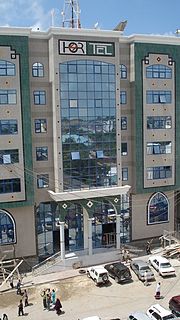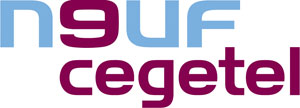Telecommunications in Belarus involves the availability and use of electronic devices and services, such as the telephone, television, radio or computer, for the purpose of communication.
Telecommunications in France is highly developed. France is served by an extensive system of automatic telephone exchanges connected by modern networks of fiber-optic cable, coaxial cable, microwave radio relay, and a domestic satellite system; cellular telephone service is widely available, expanding rapidly, and includes roaming service to foreign countries.
India's telecommunication network is the second largest in the world by number of telephone users with 1.179 billion subscribers as on 31 July 2018. It has one of the lowest call tariffs in the world enabled by mega telecom operators and hyper-competition among them. As on 31 July 2018, India has the world's second-largest Internet user-base with 460.24 million broadband internet subscribers in the country. As of 31 December 2018, India had a population of 130 crore people, 123 crore Aadhaar digital biometric identity cards, 121 crore mobile phones, 44.6 crore smartphones, 56 crore internet users up from 481 million people in December 2017, and 51 per cent growth in e-commerce.
The following is an outline of communications technology in Morocco.

Censorship and the issue of Media freedom in Russia have been main themes since the era of the telegraph. Radio was a major new technology in the 1920s, when the Communists had recently come to power. Soviet authorities realized that the "ham" operator was highly individualistic and encouraged private initiative– too much so for the totalitarian regime. Criminal penalties were imposed but the working solution was to avoid broadcasting over the air. Instead radio programs were transmitted by copper wire, using a hub and spoke system, to loudspeakers in approved listening stations, such as the "Red" corner of a factory. Due to the enormous size of the country Russia today leads in the number of TV broadcast stations and repeaters. There were few channels in the Soviet time, but in the past two decades many new state-run and private-owned radio stations and TV channels appeared.

Communications in Somalia encompasses the communications services and capacity of Somalia. Telecommunications, internet, radio, print, television and postal services in the nation are largely concentrated in the private sector. Several of the telecom firms have begun expanding their activities abroad. The federal government operates two official radio and television networks, which exist alongside a number of private and foreign stations. Print media in the country is also progressively giving way to news radio stations and online portals, as internet connectivity and access increases. In 2012, a National Communications Act was also approved by Cabinet members, which lays the foundation for the establishment of a national communications regulator in the broadcasting and telecommunications sectors.
Telecommunications in Tanzania include radio, television, fixed and mobile telephones, and the Internet available in mainland Tanzania and the semiautonomous Zanzibar archipelago.

A dark fibre or unlit fibre is an unused optical fibre, available for use in fibre-optic communication. Dark fibre originally referred to the potential network capacity of telecommunication infrastructure. Dark fibre may be leased from a network service provider.

Golden Telecom is a company that provides communication and Internet services in Russia and the Commonwealth of Independent States (CIS).
EBONE was a pan-European Internet backbone. It went online in 1992 and was deactivated in July 2002. Some portions of the Ebone were sold to other companies and continue to operate today.

Neuf Cegetel was a French wireline telecommunications service provider and a mobile virtual network operator (MVNO). It offered various telecommunications services to consumers, enterprises and wholesale customers, ranking second in the country in annual revenues. It was legally established in 2005 following the completion of the merger between Neuf Telecom and Cegetel. As of June 2008, the company became a wholly owned subsidiary of SFR, and the brand disappeared commercially.

GO p.l.c. is a Maltese integrated telecommunications company. It is a quadruple play provider that offers local and long distance telephone services, wireless services, digital terrestrial television, and DSL Internet access. GO is based in Marsa, Malta.
ALBtelecom SH.a. was established as Albania's state company that provided telecommunications services through a fixed network. On 5 December 1912 the Provisional Government led by Ismail Qemali established the Ministry of Post Telegraph Telephones, where ALBtelecom existed only as a government office. It is the largest fixed line telephone company in the country, currently covering with Optical Fiber Backbone Network the entire territory of Albanian cities.
Neterra is a Bulgarian operator for complex telecommunications services and projects in Southeast Europe. The company is established as the first alternative operator of land and satellite stations in Bulgaria. Neterra's data network covers all major cities in Bulgaria and reaches points in Georgia, Greece, Hungary, Macedonia, Romania, Serbia, Slovakia, Turkey, England, France, Netherlands and Germany.
Tata Communications formerly called VSNL is a global provider of telecommunications solutions and services. It is part of the Tata Group.

Viatel is a Dublin-based telecoms operator. Viatel make Cloud, Connectivity and Security Services Easy to Use. Viatel is the leading Irish Independent company with complete solutions for your connectivity, cloud and security requirements.
Phase3 Telecom is an aerial fiber optic network infrastructure provider, providing connectivity, network management and data storage services to wholesale, enterprise and retail customers across West Africa.The company was incorporated in 2003 and is headquartered in Abuja, Nigeria. In 2014, the company added over 1000 km to its existing 6000 km coverage area with footprint expansion of its MPLS network and fixed broadband services. They now operate a 7,000 kilometres (4,300 mi) open-access aerial fibre optic network. The company has been vital to growth in Africa's growing ICT market, implementing the Wire Nigeria Project—conceived by the Nigerian Communications Commission to help provide broadband communications access to rural communities. Phase3 has a broad range of wholesale and enterprise clients which include: Glo, MTN, 9Mobile, Ntel, Airtel, Smile Communications, Adam Smith, World Bank, UN, Julius Berger, Unity Bank, and more.Some of the African countries where the company currently has operations include Nigeria, Benin, Togo and Republic of Niger.









